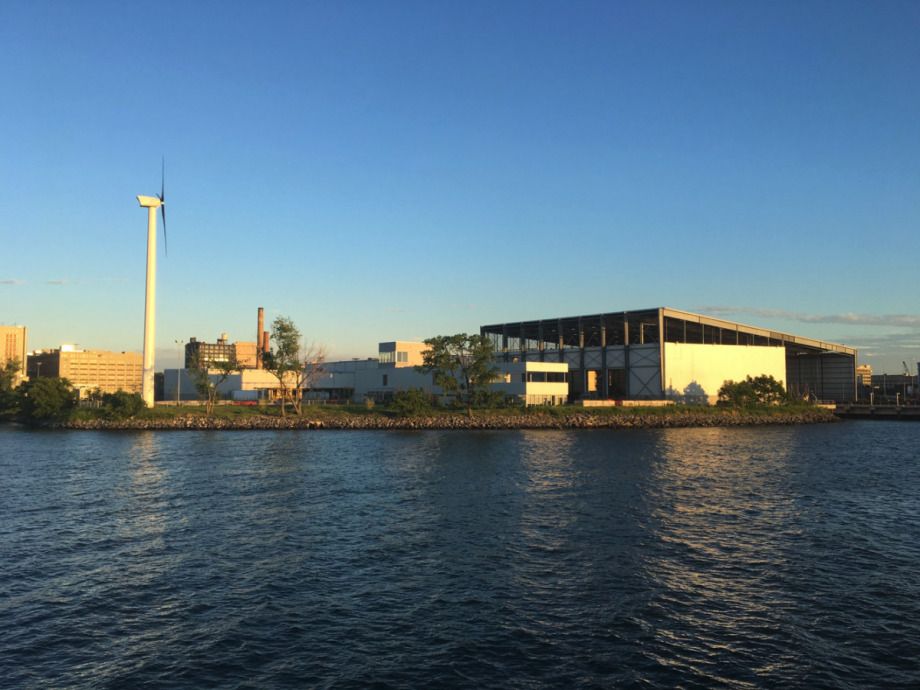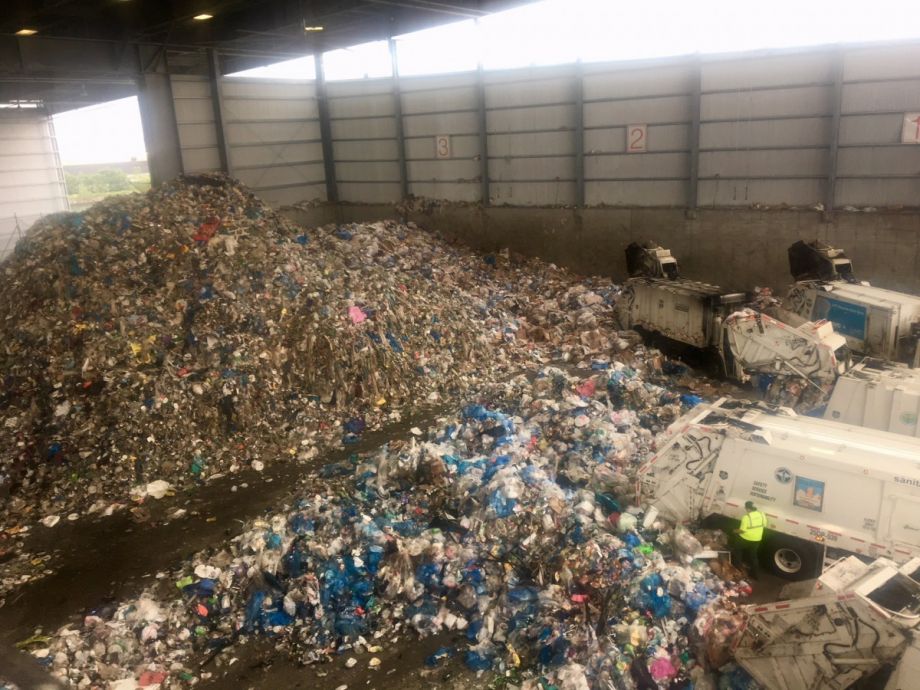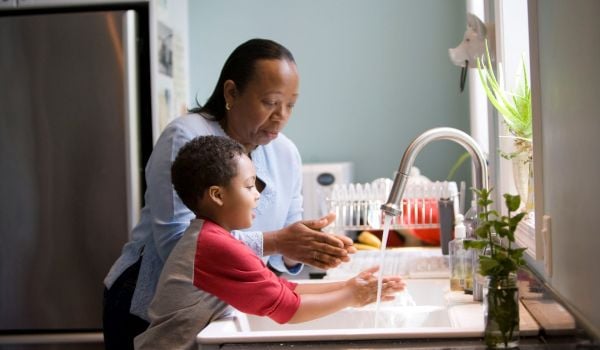New York City produces more trash than any other city on the planet by a wide margin — an estimated 33 million tons per year. The vast majority of all that waste gets sent to landfills.
While its position atop the global garbage mountain isn’t expected to change any time soon, some big changes are coming to NYC’s waste management system, one intended to reduce how much waste gets sent to landfills, and another other to address the disproportionate toll on historically marginalized communities all that trash takes on along the way. A third change in the works could further both of those goals at once.
While NYC is home to one of the largest recycling plants of its kind in the nation, it is one of the only major cities in the U.S. that doesn’t have single-stream recycling— a citywide system that allows recyclables to be collected into single containers at homes and businesses. Currently, NYC residents and businesses are still required to sort metal, glass, and plastic recyclables into one container, and paper and cardboard into another.
As it approaches its 30th anniversary of recycling, NYC is now finalizing plans to convert its waste diversion services to a single-stream system. The end goal of the initiative, slated to take effect in 2020, is to increase the city’s recycling rates by between 20 and 25 percent.
The NYC Department of Sanitation believes having just one recycling bin at home instead of two will result in less space and make it easier to remember and easier to participate, meaning potential for more efficient collection routes and improved recycling collection productivity. The capture rate of the city’s recyclables — or the amount of recyclable materials that end up at the recycling plants — now hovers around 50 percent.
“Right now, half of what is recyclable [in NYC] does not go in the right bin or does not get collected properly,” said Sam Silver, an education and outreach coordinator for Sims Municipal Recycling, a private company that processes the majority of the city’s curbside recyclables, during an August tour of company’s main recycling plant, situated on a pier in Brooklyn’s Sunset Park neighborhood.
“How many of you set out recycling this week, out on the curb?” Silver asked about 15 tour-goers, including urban designers and recycling enthusiasts. Silver says he gives around 300 tours each year of the Brooklyn facility, which opened in late 2013.
A few people eagerly raised their hands.
“If you’re in Brooklyn, and your recycling went out last night, your stuff is guaranteed to be out there right now,” he continued, gesturing at an approximately 30-foot-high pile of discards on what is known as the tipping floor, where the diverted waste is initially gathered at the plant.
The Sims facility claims to be the largest plant for mixed recyclables in North America. Under a 20-year contract as part of a public-private partnership with the NYC Department of Sanitation, Sims processes about 800 tons of material per day and prepares metal, aluminum, and rigid plastics for sale to manufacturing companies.
Each day of operation, the Sims facility receives about 100 collections of metal, glass, and plastics from most of the city by truck or barge (recyclables from Staten Island and Lower Manhattan are sent to a Sims plant in New Jersey). Next, human-operated cranes assemble the objects into enormous piles and feed them into two-and-a-half miles’ worth of conveyor belts that, with the help of optical cameras and infrared light, speedily sort the items by size, material, and even chemical makeup as needed. The flattened objects are then compressed into 1,200-plus pounds of bales that are sold to manufacturing firms across the northeast and Canada. Paper and cardboard are sent to nearby processors and paper mills.
While single-stream recycling has proven successful in other U.S. cities, the system poses certain drawbacks, like the mixing of food particles or liquids and paper that can reduce the quality of recycled materials. More significantly, changes to New York’s recycling system — even positive ones — have historically caused residential recycling rates to drop, at least initially, as households adjust to new habits.
Even after recycling rates pick back up, there’s still a risk of residents putting non-recyclable materials in the recycling bin. At present, about 85 percent of the materials Sims’ Brooklyn facility receives is recyclable. The remaining 15 percent consists of non-recyclables ranging from plastic bags and Styrofoam to miscellaneous belongings like bowling balls, shoes, trombones, and kids’ toys — all of which is sent to landfills. (The city is hoping to end the use of Styrofoam altogether by enacting a ban of it at the beginning of 2019, meaning restaurants, stores, and other businesses will be prohibited from using or selling single-use Styrofoam containers to customers.)

The Sims Municipal Recycling facility in Brooklyn's Sunset Park, including New York City’s first commercial-scale wind turbine. (Credit: Sims Municipal Recycling)
Meanwhile, the city is taking more immediate steps toward what advocates have termed “waste equity” by limiting the amount of waste collection at transfer stations in four predominantly minority communities of Brooklyn, Queens, and The Bronx. Haulers picking up trash from residences and businesses drop off waste at transfer stations, where it is held for loading onto larger trucks or barges for transit outside the city. The concentration of trash truck traffic makes reduces air quality as well as street safety on those neigborhoods. The city recently suspended a politically-connected hauler company’s license after a series of trash truck-related deaths.
On Aug. 16, Mayor de Blasio signed a bill aimed at more evenly distributing the locations of garbage and recyclables drop-off sites. The law, to take effect in Oct. 2019, mandates a reduction in the amount of waste dropped off at key transfer stations in northern Brooklyn, Queens and The Bronx, where currently three-quarters of all waste transfer drop-offs take place. Brooklyn’s Williamsburg and Greenpoint neighborhoods alone are burdened with at least 40 percent of the city’s entire daily waste, according to City Council Member Antonio Reynoso, the bill’s co-sponsor.
The flawed distribution system, says Reynoso, is an unintended consequence of the city’s closure of the Fresh Kills Landfill on Staten Island, in 2001. The city now ships trash by truck or barge to landfills in nine different states, at an estimated annual cost of $300 million.
“When [the Fresh Kills Landfill] was shut down, these transfer stations started opening up,” Reynoso explains. “So, we ended up creating unintentional environmental racism — and we haven’t reacted to it until now.”
“With the legislation,” he adds, “we’re seeking to start bringing about equity to those communities related to trash.”
That legislation also seeks to lay a foundation for another key change that would establish a system of commercial waste zones meant to reduce the number of trash trucks along city streets and better regulate the private hauler industry. The change would reduce the environmental impact of so much, perhaps too much trash truck traffic, as well as provide a regulatory framework to push through further waste-reduction strategies.
Currently, about 90 hauler companies operate across the city based on a free-market system. “These haulers often have long, overlapping routes that create unnecessary truck traffic, promote unsafe work practices, and discourage proper recycling practices,” according to a statement from the city’s OneNYC website.
Under the new system, the city would be carved up into geographic zones, and there would be a cap on the number of hauler companies that could serve restaurants, other businesses, and office buildings in each zone. Haulers would compete for contracts with more stringent safety requirements in order to be able to collect waste from each designated zone.
While improving safety for sanitation workers, the new system will allow for much-improved efficiency in truck route mileage while still allowing for customer choice, says Belinda Mager, a spokesperson for the NYC Department of Sanitation.
A 2016 study undertaken by the sanitation department and the Business Integrity Commission, which oversees trash hauler licensing for the city, found that a zone-based system has the potential for reducing waste-related truck traffic by up to 68 percent and lessening associated greenhouse gas emissions by up to 64 percent.
Zone-based systems are a topic of much debate in the waste management industry. Los Angeles made the switch to a zone-based system for commercial waste collection last year.
As was the case for Los Angeles, proponents of a zone-based system for NYC expect the new contracts will also provide a regulatory framework to get the city’s commercial sector closer to achieving “zero-waste” goals. Reynoso anticipates a bill to be passed sometime in 2019 instituting the change.
In terms of residential recycling, the city has already made strides towards zero-waste goals by collecting the highest tonnage of metal, glass and plastic recyclables in 2017 in nearly 15 years, according to its 2017 Waste Characterization Study. According to that study, New Yorkers are throwing away less than ever before.
Still, an estimated 80 percent of New York residents’ trash and recyclables end up in landfills — making the city’s goal of achieving a 100 percent recycling rate by 2030 seem like a stretch.
“People are doing a little bit better [in recycling] year by year, but not quite at the rate in which we would hit our zero-waste goals in 12 years,” said Silver, during the August tour of the Sims recycling facility. “We’ve still got a long way to go.”

Aline Reynolds is a New York-based journalist and urban planner. As a staff editor and reporter, she has chronicled the post-9/11 revitalization of Lower Manhattan, including the rebuilding of the World Trade Center. Her work has appeared in the American Planning Association’s Planning Magazine, Agence-France Presse, and Newsday.
.(JavaScript must be enabled to view this email address)
















